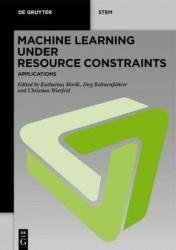 Название: Machine Learning under Resource Constraints, Volume 3: Applications
Название: Machine Learning under Resource Constraints, Volume 3: ApplicationsАвтор: Katharina Morik, Jorg Rahnenfuhrer, Christian Wietfeld
Издательство: De Gruyter
Год: 2023
Страниц: 478
Язык: английский
Формат: pdf (true), epub
Размер: 90.8 MB
Machine Learning under Resource Constraints addresses novel Machine Learning algorithms that are challenged by high-throughput data, by high dimensions, or by complex structures of the data in three volumes. Resource constraints are given by the relation between the demands for processing the data and the capacity of the computing machinery. The resources are runtime, memory, communication, and energy. Hence, modern computer architectures play a significant role. Novel Machine Learning algorithms are optimized with regard to minimal resource consumption. Moreover, learned predictions are executed on diverse architectures to save resources. It provides a comprehensive overview of the novel approaches to Machine Learning research that consider resource constraints, as well as the application of the described methods in various domains of science and engineering.
Volume 3 describes how the resource-aware Machine Learning methods and techniques are used to successfully solve real-world problems. The book provides numerous specific application examples. In the areas of health and medicine, it is demonstrated how Machine Learning can improve risk modelling, diagnosis, and treatment selection for diseases. Machine Learning supported quality control during the manufacturing process in a factory allows to reduce material and energy cost and save testing times is shown by the diverse real-time applications in electronics and steel production as well as milling. Additional application examples show, how machine-learning can make traffic, logistics and smart cities more effi cient and sustainable. Finally, mobile communications can benefi t substantially from Machine Learning, for example by uncovering hidden characteristics of the wireless channel.
Machine learning obtains predictions by constructing a predictive model. Many machine learning algorithms are built on black-box models, as opposed to statistical learning, which is more concerned with the statistical properties of the model, such as the distribution of the variables and its parameters. In this section, we focus on the problem of data- and dimensionality-reduction in Bayesian statistics. Bayesian regression does not assume a fixed optimal solution for a dataset as in the frequentist case, but introduces a distribution over the parameter space. The likelihood function models the information that comes from the data, and the prior distribution models problem-specific prior knowledge. Our goal is to explore and characterize the posterior distribution, which, as a consequence of Bayes’ theorem, is a compromise between the observed data situation and the prior knowledge that we assume for the parameters. For very large and high-dimensional datasets and settings where computational resources are scarce, the posterior distribution is hard to obtain. In general, our work focuses on algorithmic approaches that can be implemented in streaming and distributed environments to reduce the underlying problem in order to enhance the scalability of modern Bayesian regression approaches.
Swarm algorithms create a group dynamic similar to the swarm behavior of animals, such as a flock of birds or a school of fish. Craig Reynolds developed a simulated swarm behavior in 1987 with the help of these observations. In logistics systems, a swarm algorithm is similar to traffic rules, which enable a smooth traffic flow by observing the local environment with as little communication as possible between the vehicles. One advantage of using swarm algorithms in logistics is that they do not require fixed routes but can use all available spaces. This allows them to easily change the layout and react to unpredictable events or disruptions. Furthermore, due to the modular design of swarm algorithms, new behaviors can be added without altering the existing ones. The paradigm of swarm behavior aims to enable several independent robots to collaborate towards achieving a collective goal, acting as a swarm.
Contents:
1. Editorial
2. Health / Medicine
3. Industry 4.0
4. Smart City and Traffic
5. Communication Networks
6. Privacy
Bibliography | 413
Index 461
Скачать Machine Learning under Resource Constraints, Volume 3: Applications